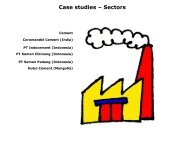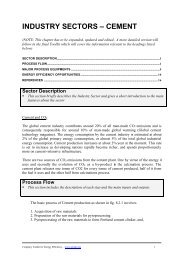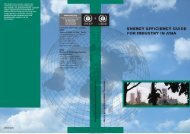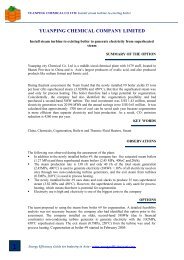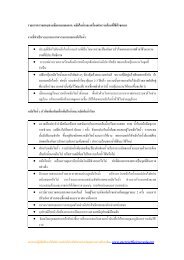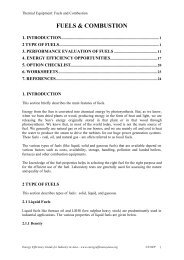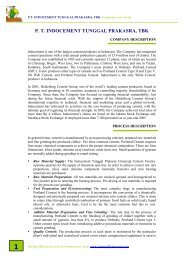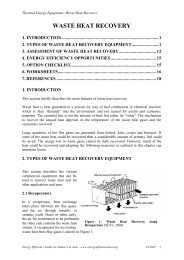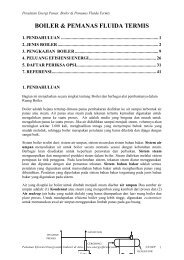Chapter – Cooling Towers - RETScreen International
Chapter – Cooling Towers - RETScreen International
Chapter – Cooling Towers - RETScreen International
You also want an ePaper? Increase the reach of your titles
YUMPU automatically turns print PDFs into web optimized ePapers that Google loves.
Electrical Energy Equipment: <strong>Cooling</strong> <strong>Towers</strong>1.2 Components of a cooling towerThe basic components of a cooling tower include the frame and casing, fill, cold-water basin,drift eliminators, air inlet, louvers, nozzles and fans. These are described below. 1Frame and casing. Most towers have structural frames that support the exterior enclosures(casings), motors, fans, and other components. With some smaller designs, such as someglass fiber units, the casing may essentially be the frame.Fill. Most towers employ fills (made of plastic or wood) to facilitate heat transfer bymaximizing water and air contact. There are two types of fill:• Splash fill: water falls over successive layers of horizontal splash bars, continuouslybreaking into smaller droplets, while also wetting the fill surface. Plastic splash fillspromote better heat transfer than wood splash fills.• Film fill: consists of thin, closely spaced plastic surfaces over which the water spreads,forming a thin film in contact with the air. These surfaces may be flat, corrugated,honeycombed, or other patterns. The film type of fill is the more efficient and providessame heat transfer in a smaller volume than the splash fill.Cold-water basin. The cold-water basin is located at or near the bottom of the tower, and itreceives the cooled water that flows down through the tower and fill. The basin usually has asump or low point for the cold-water discharge connection. In many tower designs, the coldwaterbasin is beneath the entire fill. In some forced draft counter flow design, however, thewater at the bottom of the fill is channeled to a perimeter trough that functions as the coldwaterbasin. Propeller fans are mounted beneath the fill to blow the air up through the tower.With this design, the tower is mounted on legs, providing easy access to the fans and theirmotors.Drift eliminators. These capture water droplets entrapped in the air stream that otherwisewould be lost to the atmosphere.Air inlet. This is the point of entry for the air entering a tower. The inlet may take up anentire side of a tower (cross-flow design) or be located low on the side or the bottom of thetower (counter-flow design).Louvers. Generally, cross-flow towers have inlet louvers. The purpose of louvers is toequalize air flow into the fill and retain the water within the tower. Many counter flow towerdesigns do not require louvers.Nozzles. These spray water to wet the fill. Uniform water distribution at the top of the fill isessential to achieve proper wetting of the entire fill surface. Nozzles can either be fixed andspray in a round or square patterns, or they can be part of a rotating assembly as found insome circular cross-section towers.Fans. Both axial (propeller type) and centrifugal fans are used in towers. Generally, propellerfans are used in induced draft towers and both propeller and centrifugal fans are found inforced draft towers. Depending upon their size, the type of propeller fans used is either fixed1 Section 1.2 is taken in its entirety from <strong>Cooling</strong> <strong>Towers</strong>. In: Energy Efficiency in Electrical Utilities. <strong>Chapter</strong> 7, pg 135 -151. 2004, with the permission from Bureau of Energy Efficiency, Ministry of Power, IndiaEnergy Efficiency Guide for Industry in Asia <strong>–</strong> www.energyefficiencyasia.org ©UNEP 2



